A Guide to the Bangkok Public Bus System
You will quickly notice that there are many different kinds of public buses roaming the streets of Bangkok.
This fact, added to the pretty chaotic traffic of the city, means that travelling on the Bangkok Public bus system can be very confusing!
Some buses are air-conditioned and some buses are non-air-conditioned (or regular). Some buses are big, while some buses are small (minibuses).
You will also certainly notice that city buses are very colourful: red, pink, yellow, orange, blue...
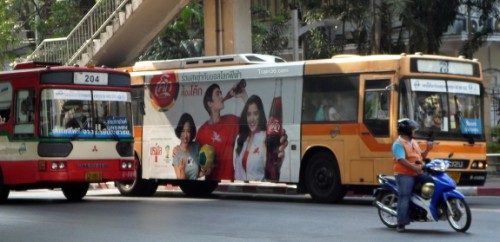 A red / cream regular bus and an orange air-conditioned Bangkok Public Bus
A red / cream regular bus and an orange air-conditioned Bangkok Public BusAll these buses are part of the Bangkok Mass Transit Authority (BMTA), which is operated by the Ministry of Transport and Communications.
Some of these buses are actually owned by some private companies, but they still run under the Ministry of Transport and Communications.
Operating Hours:
Most of the buses run from 5:00 AM to 11:00 PM, except for some lines which are opened 24 hours.
The bus stops are quite obvious in Bangkok, there are either bus shelters or blue signs standing on the sidewalk / pavement.
All the bus lines are written on the bus stops and you might notice the Thai letters: ปอ and ปอพ.
ปอ is the Thai abbreviation for ปรับอากาศ = Air-conditioned, so ปอ 2 = Air-con bus 2.
ปอพ is the Thai abbreviation for ปรับอากาศพิเศษ = Special Air-conditioned, so ปอพ 76 = Special air-con bus 76.
On the bus windscreen is usually written the origin station and the terminal station, while the bus route is written on the sides of the bus (unfortunately many buses only feature this piece of information in Thai, while only a few feature it in Thai and also in English).

Buddhist monks and novices travel for free and have reserved seats in all buses.
Be careful:
Buses with the same numbers but of different colours don't necessarily follow the same route.
Also be aware that some buses (like the Orange air-con 511 or the Red non-air-con bus 2) follow two different routes: the normal route and the express route through the expressway.
In that case the bus features a yellow sign on the windscreen and also on the side which says: “ทางด่วน” (= Expressway).

This sign is written either in Thai only or in Thai and English.
If
you see the “Expressway” sign just ask the conductor if the bus is
still stopping at your expected destination, as the buses taking the
expressway obviously skip some stops from the original route.
Red non-air-con buses taking the expressway charge an extra 2 THB per ticket (8.50THB).
Some buses have the Thai letter ก (equivalent to A) or ข (equivalent to B) after their numbers.
The routes of the buses which feature one of these 2 letters are different from the original routes.
For
example there is the Orange air-con bus 73 and the Orange air-con bus
73ก. These two buses don't follow exactly the same route. Be vigilant if
you don’t want to get lost!
To make it simple:
The air-con buses charge according to the travelled distance.
After boarding an air-con bus, you will have to mention your destination to the conductor who is going back and forth in the bus and who will let you know the ticket price.

Air-con buses in Bangkok are Orange, Yellow, White or Blue / White.
Bangkok Public Bus Fares
In 2014 the fare system for these different air-con buses are :
- Orange air-con buses = from 11 THB to 24 THB depending on the distance

- Yellow air-con buses = from 12 THB to 24 THB depending on the distance

- White air-con buses = from 11 THB to 23 THB depending on the distance
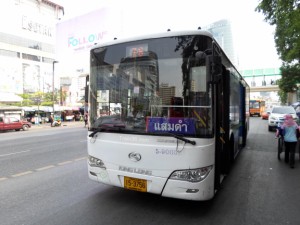
- Blue / White air-con buses = from 11 THB to 19 THB

The buses serving both Suvarnabhumi and Don Muang (549, 550, 551, 552, 553, 554, 555, 558, 559) don't follow the fare system as explained above.
Tickets on these buses are priced from 24 to 35 THB.
The non-air-con buses charge a flat rate.
In 2014 the non-air-con buses or regular buses are: Red (known also as Red cream), Blue / White, Pink, Green (minibuses), Orange (minibuses)...
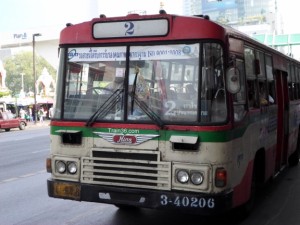
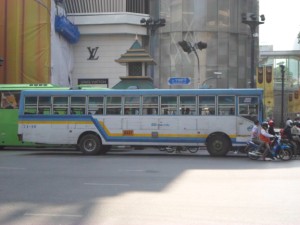
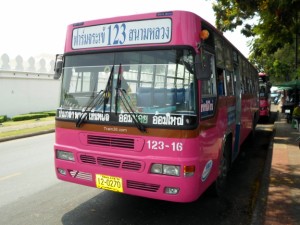

All the non-air-con buses charge a flat rate of 8 THB, except for the Red non-air-con buses which charge a flat rate of 6.50 THB / 8 THB after 10PM / 8.50 THB for the buses taking the expressway.
Note that some Red non air-con buses are free. These free buses feature a sign (in Thai only) on their windscreens, at the rear and on the sides that says:
รถเมล์ฟรี จากภาษีประชาชน
(= Free buses from public taxes)

This free bus scheme is one of the populist schemes voted under the Thaksin Shinawatra’s government.
At the time of its introduction, as many as 50 % of the Red cream regular buses were free, despite the fact that the BMTA is very indebted.
The scheme, which was supposed to be a temporary scheme is still going on, but nowadays there are fewer free buses.
Monthly bus pass and weekly bus pass in Bangkok :
The BMTA sells weekly passes and monthly bus passes. There are not that many selling points and all the information are only in Thai, so at first it is not that obvious for foreigners.
There is a selling point on Ratchadamri road (ถนนราชดำริ) located at the bus stop besides the BIG C shopping centre entrance. One employee of the BMTA sells the passes right at the bus shelter.

The pass for Red non-air-con buses is priced at 100 THB for a week and 400 THB for a month.
The pass for all air-con buses is priced at 200 THB for a week and 800 THB for a month.
Bus Rapid Transit (BRT)
In 2010 a Bus Rapid Transit (BRT) line opened and it was supposed to be the 1st line of a of 5 line network which eventually never materialized.
The line (around 16 km) is made of 12 stations and connects Sathorn (in Bangkok near Silom) to Ratchaphruek (in Thonburi near Talat Phlu) in around 30 minutes.
Parts of the roads on which the BRT buses run are physically separated from the rest of the roads and reserved for the use of the BRT buses exclusively.
This way the BRT buses run smoothly without being affected by the traffic.

Sathorn BRT station is connected to the BTS Chong Nonsi station by a big Sky Bridge that stands over the Narathiwat-Sathorn Intersection.

Ratchaphruek BRT station is connected to the BTS Talat Phlu station.
To see the line in details go to:
A BRT ticket costs a flat rate of 5 THB (2014) and can be purchased at the ticket counters or the ticket selling machines which are located at each station.

All BRT buses are yellow.
The Bangkok Mass Transit Authority (BMTA) has been trying to improve the service of its buses due to regular complaints for speeding or rudeness.
Some bus routes have even attracted the interest of the media for their dangerousness or the impoliteness of their drivers and conductors.
For example, the bus route number 8 which connects Memorial Bridge to Happy Land, was declared in 2014 as the most dangerous route by the people of Bangkok and has attracted a lot of negative comments notably on the social media.
The drivers of the Green and Orange non-air-con minibuses are well-known for their fast and risky way of driving.
Added to the fact that these buses are very often crowded you will have to hold tight if you don’t want to fall over!
To find your bus in Bangkok go to:
www.transitbangkok.com/bangkok_buses.html or www.bmta.co.th/?q=en/bus-lines
